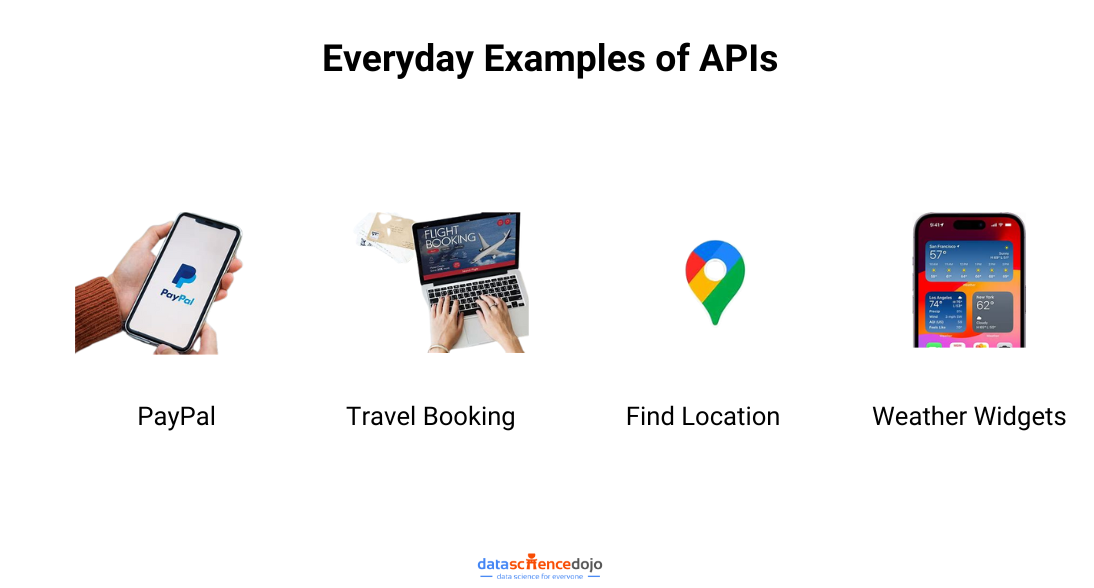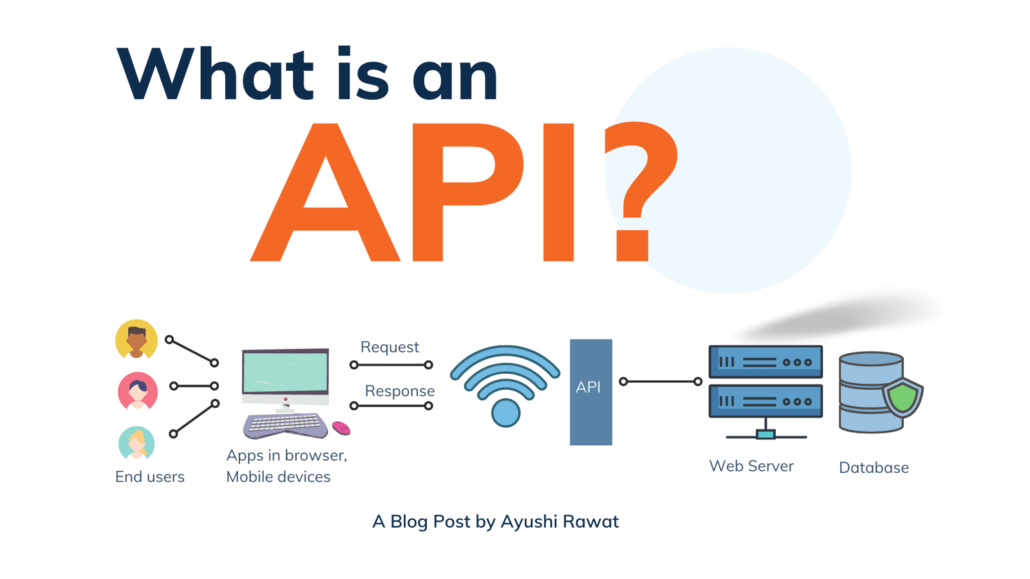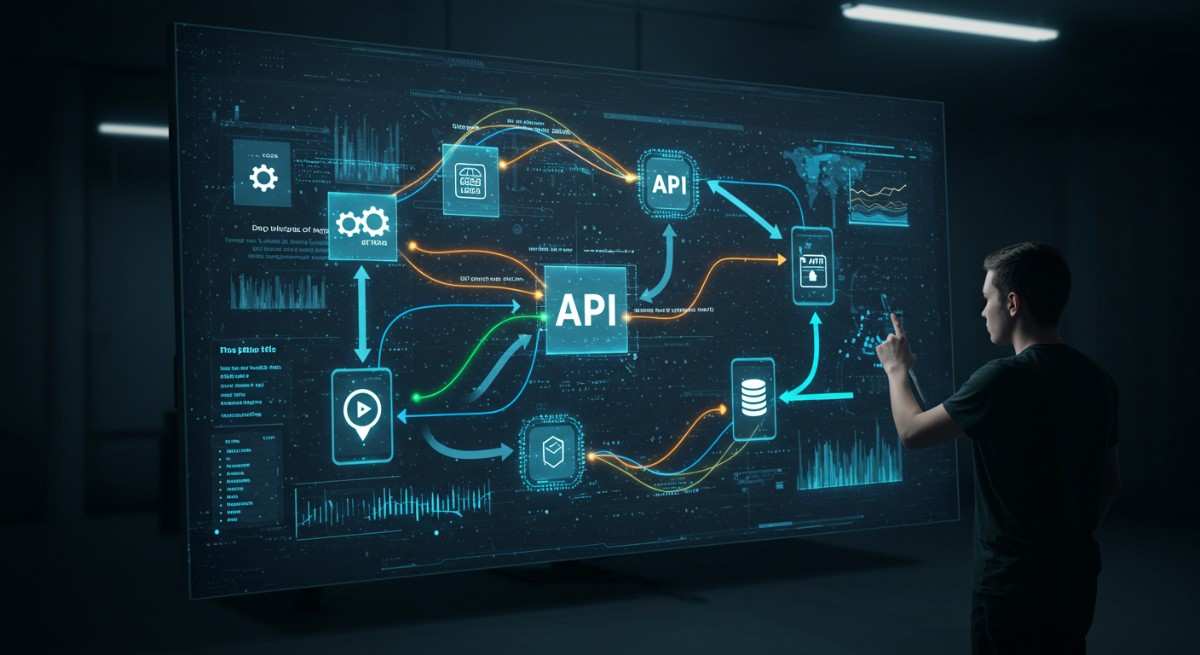APIs (Application Programming Interfaces) are a crucial component of modern software development. They act as bridges that allow different software systems to communicate and share data seamlessly.
By enabling this interaction, APIs make it possible for developers to build new applications quickly and efficiently. Instead of creating everything from scratch, developers can leverage existing functionalities, saving time and effort.
In this blog post, we will introduce APIs, explore their functionality, and discuss how they simplify software development. Whether you’re a beginner or an experienced developer, understanding APIs is essential in today’s tech-driven world.
What are APIs?
Let’s get a clearer and more technical explanation of APIs.
An Application Programming Interface (API) is a set of defined rules, protocols, and tools that enable different software applications to communicate with each other. It acts as an intermediary, allowing one system to request and exchange data or services from another system efficiently.
APIs define how software components should interact, specifying the structure of requests and responses. This ensures seamless communication between different platforms, regardless of the programming languages or technologies they use.
For example, when you use a weather app to check the forecast, the app doesn’t generate the data itself. Instead, it sends a request to an API, which fetches weather information from a remote server and delivers it back to the app. This process happens in real-time, providing users with up-to-date data.
APIs play a fundamental role in web development, mobile applications, cloud computing, and countless other areas of modern technology. They enable integration with third-party services, automate processes, and enhance functionality without requiring developers to reinvent the wheel.

Types of APIs
APIs come in various forms, each serving a specific purpose in software development. Understanding the different types of APIs helps developers choose the right one for their needs. Below are the key categories:
1. Web-Based APIs
Web-based APIs facilitate communication over the internet using standard protocols like HTTP or HTTPS. They allow applications to send requests and retrieve data from remote servers, typically returning responses in structured formats such as JSON or XML.
These APIs are widely used in web and mobile applications, enabling features like retrieving weather updates, making online payments, or accessing social media platforms. Examples include RESTful APIs and GraphQL APIs, which allow efficient data exchange between clients and servers.
2. Local APIs
Local APIs operate directly on a computer, device, or within an application. They enable programs to interact with system components, libraries, or hardware without requiring internet access.
Developers use programming languages like Python, Java, or C++ to access these APIs. A common example is the Windows API, which provides developers with functions to interact with the Windows operating system, such as file handling, graphics rendering, and memory management.
Give it a read too: Postman & Python: API Testing Made Easy
3. Software Integration APIs
These APIs enable different software programs or components to work together. They are essential for database connections, operating system interactions, and communication between microservices or third-party services.
For instance, an API might allow a CRM system to integrate with an email marketing platform, ensuring customer data is synchronized automatically. Similarly, messaging services like Slack and Microsoft Teams use APIs to connect with external applications, enabling seamless collaboration.
Each type of API serves a unique purpose, but they all contribute to making software development more efficient, flexible, and scalable. By leveraging APIs, developers can integrate powerful features into applications without reinventing the wheel.
How Do They Work?
These communication bridges function by enabling different software systems to interact seamlessly. They follow a client-server model, where one system (the client) sends a request, and another system (the server) processes it and responds with the required data or confirmation of an action. This setup ensures that applications can work together efficiently without needing direct access to each other’s internal workings.

1. The Client-Server Process
The client, which can be a mobile app, web browser, or another software system, sends a request asking for data or specific services. The server, often a remote database or cloud platform, receives this request, processes it, and sends back a response.
For instance, when using a navigation app, the system retrieves real-time traffic information from an external source. The client sends a request for updated road conditions, and the server returns details on congestion, alternative routes, or estimated arrival times.
You might also like: Rest API
2. Requests and Responses
Most modern systems communicate using Hypertext Transfer Protocol (HTTP or HTTPS). A request typically includes:
- The Action Type – Defines what the client wants to do, such as retrieving, updating, or deleting information.
- The Resource Address – Specifies where the request should be sent, usually a unique web address.
- Additional Information – Can include details such as user credentials or filters for refining search results.
Once processed, the server sends back a response containing:
- A Status Indicator – Shows whether the request was successful or if an error occurred.
- Structured Data – The requested information, formatted in a way that the client can easily interpret and use.
3. Data Formatting for Easy Exchange
To ensure smooth communication, responses are typically formatted using standardized structures. The most common formats include:
- Lightweight, text-based formats that are easy for both humans and machines to read.
- More structured formats that provide additional detail, often used in complex systems.
These formats help different applications interpret and process the exchanged information without compatibility issues.
4. Secure Communication
To protect sensitive data, access is often restricted through security measures such as:
- Unique Keys assigned to authorized users.
- Secure Login Systems that verify identity before granting access.
- Encryption Techniques that ensure transmitted data remains private.
These safeguards prevent unauthorized users from accessing or altering the data being exchanged
Use Cases for APIs
These communication tools play a vital role in modern software development, enabling seamless integration, automation, and data exchange across different platforms. They enhance efficiency, streamline workflows, and empower developers to build robust applications with minimal effort.
1. Connecting Different Systems
One of the most significant benefits is the ability to link multiple systems or applications. By facilitating smooth data transfer between different platforms, businesses can integrate various services without requiring complex manual processes.
For example, an e-commerce website can connect with a payment gateway to process transactions, retrieve shipping information from a logistics provider, and synchronize inventory with a warehouse management system. This level of automation ensures that all components work together effortlessly.
2. Automating Repetitive Tasks
Automation is a key advantage, helping developers reduce manual workload and save valuable time. Instead of performing repetitive actions manually, these tools allow for scheduled operations, such as data synchronization, report generation, or email notifications.
For instance, marketing platforms use this capability to automatically update customer information, send personalized emails, and track user engagement, all without requiring human intervention.
3. Enabling Third-Party Development
Many companies offer external developers access to certain functionalities, allowing them to build their own applications using existing data and services. These publicly available tools provide a foundation for innovation, enabling startups, enterprises, and independent developers to enhance or extend existing platforms.
A great example is social media platforms that allow third-party applications to integrate messaging features, schedule posts, or analyze engagement metrics. This openness fosters collaboration and expands the ecosystem of available applications.
Also learn how to simplify API interactions
4. Powering Mobile and Web Applications
Modern mobile and web applications rely on these tools to fetch and update data in real-time. Whether it’s a news app pulling the latest headlines, a fitness app syncing workout progress, or a ride-sharing platform retrieving driver locations, seamless data exchange ensures a smooth user experience.
By acting as a bridge between front-end interfaces and back-end systems, these tools enable applications to remain lightweight while accessing powerful server-side functionalities on demand.
5. Delivering Real-Time Updates and Notifications
Instant data retrieval and live updates are crucial in many industries, from finance to weather forecasting. By establishing continuous communication channels, these systems provide users with up-to-the-minute information.
For example, a stock market tracking application displays real-time price changes, a messaging app delivers instant notifications, and a navigation service provides live traffic updates. This ensures users always have the latest information at their fingertips.
Challenges Associated with Utilizing APIs
APIs have become an essential tool for businesses to connect and exchange data between various applications and services. However, with this convenience, come certain challenges that businesses need to be aware of:
1. Security Concerns
One of the biggest risks involves unauthorized access to confidential information. If not properly secured, sensitive data can be exposed, making it an attractive target for hackers. Cybercriminals may attempt to intercept data, exploit weak authentication methods, or launch attacks to gain unauthorized control over systems.
To mitigate these risks, strong security measures must be implemented, such as:
- Authentication and Authorization – Using robust security protocols like OAuth, API keys, or multi-factor authentication ensures that only authorized users can access sensitive data.
- Encryption – Encrypting data both in transit and at rest prevents interception by malicious actors.
- Rate Limiting and Monitoring – Setting restrictions on the number of requests a user can make within a certain timeframe helps prevent abuse, while continuous monitoring can detect suspicious activity.
Without these safeguards, businesses risk data breaches, loss of customer trust, and potential legal consequences.
2. Integration Challenges
Integrating external services into an existing system is not always straightforward. Compatibility issues, outdated documentation, and differences in data formats can make the process complex and time-consuming.
Some common obstacles include:
- Version Mismatches – If an existing system is built on older technology, integrating newer services may require extensive modifications.
- Inadequate Documentation – Poorly documented services make it difficult for developers to understand how to implement them effectively.
- Latency and Performance Issues – A slow or inefficient integration can degrade the overall performance of an application, leading to poor user experiences.
To overcome these challenges, businesses should ensure thorough testing before deployment, maintain up-to-date system documentation, and consider middleware solutions that simplify integration.
3. Limited Control Over Third-Party Services
When relying on third-party providers, businesses have little control over how these services operate. Any changes made by the provider—such as modifications to features, pricing structures, or availability—can directly impact applications that depend on them.
Potential risks include:
- Service Disruptions – If the provider experiences downtime, all dependent applications may be affected.
- Unexpected Feature Changes – Alterations in functionality may break existing workflows or require costly adjustments.
- Service Discontinuation – If a provider decides to shut down their service, businesses relying on it must quickly find alternatives or rebuild key components.
To mitigate these risks, organizations should:
-
- Use Reliable and Well-Established Providers – Choosing services with a strong reputation and long-term stability reduces uncertainty.
- Implement Backup Plans – Having contingency strategies, such as fallback services or in-house alternatives, minimizes disruptions.
- Monitor Service Changes – Regularly reviewing provider updates ensures businesses can adapt to changes before they cause major issues.
Popular APIs
APIs are widely used across industries and here are some examples of popular APIs:
-
Google Maps Integration – A widely used service that helps businesses in transportation, logistics, and delivery services by providing precise location data, real-time traffic updates, route optimization, and geocoding services. It enhances navigation, improves efficiency, and allows businesses to offer better customer experiences through location-based services.
-
Twitter Integration – Enables businesses to access and analyze real-time tweets, hashtags, and user interactions. By integrating this data into their platforms, companies can track trends, conduct sentiment analysis, and monitor brand mentions, making it a valuable tool for social media engagement, customer feedback analysis, and marketing insights.
-
Facebook Integration – Allows businesses to connect their applications with Facebook’s platform, accessing user data, business pages, and analytics. This integration supports targeted social media marketing, enhances customer interactions, and provides insights into user engagement, helping businesses optimize their digital presence and advertising strategies.
Explanation of Documentation
For seamless integration and efficient development, clear and well-structured documentation is essential. It serves as a comprehensive guide, providing developers with instructions on how to integrate a system, service, or platform into their applications. By outlining key functionalities, parameters, and endpoints, it ensures that users can effectively understand and utilize the available features.
This documentation often includes response examples, error-handling guidelines, and sample implementations to assist developers in troubleshooting and implementation. Depending on the programming language and development environment, it can be presented in formats such as HTML, PDF, or Markdown for easy accessibility.
Well-structured and easy-to-navigate documentation enhances the developer experience by providing clear use cases, detailed explanations, and intuitive organization. Beyond its technical purpose, it can also act as a marketing tool, attracting new users by showcasing the value of a service and how it can solve specific problems efficiently.
To maintain accuracy and relevance, regular updates are necessary. Keeping the documentation up to date ensures that developers always have the latest information, reflecting any changes, improvements, or new features introduced over time.
Wrapping Up
APIs have become an integral part of modern software development, enabling seamless communication between systems, enhancing automation, and expanding the capabilities of applications. From integrating third-party services to automating workflows and providing real-time data, they play a crucial role in improving efficiency and user experience.
However, along with their benefits, APIs come with challenges such as security risks, integration complexities, and reliance on third-party providers. Addressing these concerns through robust security measures, thorough documentation, and strategic planning ensures smooth implementation and long-term reliability.
As technology continues to evolve, APIs will remain a fundamental building block for innovation, allowing businesses to create more connected, scalable, and efficient digital solutions. Whether for mobile apps, cloud services, or enterprise software, leveraging APIs effectively can drive growth and streamline operations in an increasingly interconnected world.





